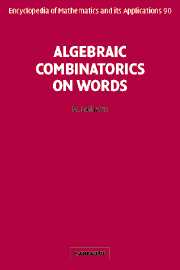Book contents
- Frontmatter
- Contents
- Preface
- Chapter 1 Finite and Infinite Words
- Chapter 2 Sturmian Words
- Chapter 3 Unavoidable Patterns
- Chapter 4 Sesquipowers
- Chapter 5 The Plactic Monoid
- Chapter 6 Codes
- Chapter 7 Numeration Systems
- Chapter 8 Periodicity
- Chapter 9 Centralizers of Noncommutative Series and Polynomials
- Chapter 10 Transformations on Words and q-Calculus
- Chapter 11 Statistics on Permutations and Words
- Chapter 12 Makanin's Algorithm
- Chapter 13 Independent Systems of Equations
- References
- Index of Notation
- General Index
Chapter 2 - Sturmian Words
Published online by Cambridge University Press: 05 April 2013
- Frontmatter
- Contents
- Preface
- Chapter 1 Finite and Infinite Words
- Chapter 2 Sturmian Words
- Chapter 3 Unavoidable Patterns
- Chapter 4 Sesquipowers
- Chapter 5 The Plactic Monoid
- Chapter 6 Codes
- Chapter 7 Numeration Systems
- Chapter 8 Periodicity
- Chapter 9 Centralizers of Noncommutative Series and Polynomials
- Chapter 10 Transformations on Words and q-Calculus
- Chapter 11 Statistics on Permutations and Words
- Chapter 12 Makanin's Algorithm
- Chapter 13 Independent Systems of Equations
- References
- Index of Notation
- General Index
Summary
Introduction
Sturmian words are infinite words over a binary alphabet that have exactly n + 1 factors of length n for each n ≥ 0. It appears that these words admit several equivalent definitions, and can even be described explicitly in arithmetic form. This arithmetic description is a bridge between combinatorics and number theory. Moreover, the definition by factors makes Sturmian words define symbolic dynamical systems. The first detailed investigations of these words were done from this point of view. Their numerous properties and equivalent definitions, and also the fact that the Fibonacci word is Sturmian, have led to a great development, under various terminologies, of the research.
The aim of this chapter is to present basic properties of Sturmian words and of their transformation by morphisms. The style of exposition relies basically on combinatorial arguments.
The first section is devoted to the proof of the Morse–Hedlund theorem stating the equivalence of Sturmian words with the set of balanced aperiodic words and the set of mechanical words of irrational slope. We also mention several other formulations of mechanical words, such as rotations and cutting sequences. We next give properties of the set of factors of one Sturmian word, such as closure under reversal, the minimality of the associated dynamical system, the fact that the set depends only on the slope, and we give the description of special words.
Information
- Type
- Chapter
- Information
- Algebraic Combinatorics on Words , pp. 45 - 110Publisher: Cambridge University PressPrint publication year: 2002
Accessibility standard: Unknown
Why this information is here
This section outlines the accessibility features of this content - including support for screen readers, full keyboard navigation and high-contrast display options. This may not be relevant for you.Accessibility Information
- 15
- Cited by
